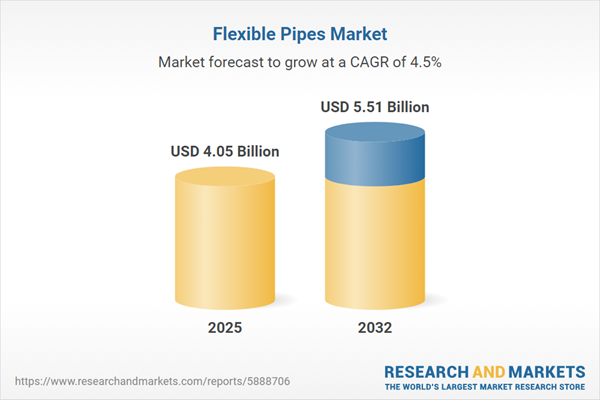Speak directly to the analyst to clarify any post sales queries you may have.
The flexible pipes market is evolving rapidly, offering critical solutions for sectors facing complex fluid transport and infrastructure challenges. As innovation and regulatory changes accelerate, decision-makers require agile, data-driven insights into material advancements, emerging applications, and trade dynamics shaping this sector.
Market Snapshot: Flexible Pipes Market Size and Growth
The Flexible Pipes Market grew from USD 3.87 billion in 2024 to USD 4.05 billion in 2025. It is expected to continue growing at a CAGR of 4.50%, reaching USD 5.51 billion by 2032.
Scope & Segmentation
- Material: HDPE, PEX, PVC, Steel
- Product Type: Composite, Corrugated, Reinforced, Smooth Interior
- Application: Chemical Processing (Acid Resistant, Alkali Resistant), Oil and Gas (Downstream, Midstream, Upstream), Sewage Discharge (Sanitary, Stormwater), Water Supply (Irrigation, Potable Water)
- End Use: Agricultural, Industrial, Municipal, Residential
- Diameter: Large Size (>150 mm), Medium Size (50-150 mm), Small Size (<50 mm)
- Pressure Rating: High Pressure (>16 Bar), Medium Pressure (6-16 Bar), Low Pressure (<6 Bar)
- Regions: Americas (North America, Latin America), Europe, Middle East & Africa (Europe, Middle East, Africa), Asia-Pacific
- Major Countries: United States, Canada, Mexico, Brazil, Argentina, Chile, Colombia, Peru, United Kingdom, Germany, France, Russia, Italy, Spain, Netherlands, Sweden, Poland, Switzerland, United Arab Emirates, Saudi Arabia, Qatar, Turkey, Israel, South Africa, Nigeria, Egypt, Kenya, China, India, Japan, Australia, South Korea, Indonesia, Thailand, Malaysia, Singapore, Taiwan
- Key Companies: TechnipFMC plc, Trelleborg AB, Baker Hughes Company, NOV Inc., Schlumberger Limited, Aker Solutions ASA, NKT A/S, Dalian Shihua Group Co., Ltd., MTG Limited, Corrodene Ltd.
Key Takeaways: Strategic Insights for Senior Decision-Makers
- Material advancements are expanding the operational envelope for flexible pipes, enabling use in corrosive and high-pressure scenarios across a range of sectors.
- Digitalization is driving next-generation products, with smart instrumentation and real-time monitoring boosting maintenance efficiency and asset integrity.
- Segmented applications such as oil and gas, chemical processing, and municipal infrastructure require highly tailored pipe configurations and compliance with stringent regulatory environments.
- Shifting end-user requirements—and increasing demand for rapid, modular installation—favor solutions that reduce project timelines and total lifecycle costs.
- Strategic partnerships and cross-sector collaboration are accelerating innovation, addressing both regional compliance needs and performance expectations.
- Effective portfolio management is increasingly critical for addressing segment-specific opportunities and niche growth pockets within each regional market.
Tariff Impact and Global Supply Chain Considerations
Recent United States tariff measures on imported polymers and reinforcements have prompted manufacturers to adjust sourcing and production strategies. Many are relocating operations closer to end-markets or forming collaborative procurement arrangements to counter increased duty costs and volatility in raw material pricing. These shifts underscore the importance of agile supply chain management and robust risk mitigation for stakeholders navigating the flexible pipes marketplace.
Methodology & Data Sources
This report integrates secondary research, including technical literature and industry publications, with structured interviews from industry executives such as engineers and procurement managers. All findings were validated using a triangulation approach to ensure accuracy, minimizing discrepancies and ensuring balanced market insight.
Why This Report Matters
- Empowers leaders with actionable intelligence on emerging technologies, market segmentation, and regulatory changes shaping flexible pipe adoption.
- Supports risk-informed decision making by highlighting tariff impacts, supply chain adaptations, and evolving end-user needs across global regions.
- Enables strategic planning around product development, sourcing, and partnership opportunities in a dynamic and competitive landscape.
Conclusion
The flexible pipes market is defined by rapid innovation, shifting regulations, and diverse regional requirements. Stakeholders who adapt strategies to segmented demand, technological change, and trade complexities will be positioned for sustainable growth and industry leadership.
Additional Product Information:
- Purchase of this report includes 1 year online access with quarterly updates.
- This report can be updated on request. Please contact our Customer Experience team using the Ask a Question widget on our website.
Table of Contents
3. Executive Summary
4. Market Overview
7. Cumulative Impact of Artificial Intelligence 2025
Companies Mentioned
The companies profiled in this Flexible Pipes market report include:- TechnipFMC plc
- Trelleborg AB
- Baker Hughes Company
- NOV Inc.
- Schlumberger Limited
- Aker Solutions ASA
- NKT A/S
- Dalian Shihua Group Co., Ltd.
- MTG Limited
- Corrodene Ltd.
Table Information
| Report Attribute | Details |
|---|---|
| No. of Pages | 180 |
| Published | October 2025 |
| Forecast Period | 2025 - 2032 |
| Estimated Market Value ( USD | $ 4.05 Billion |
| Forecasted Market Value ( USD | $ 5.51 Billion |
| Compound Annual Growth Rate | 4.5% |
| Regions Covered | Global |
| No. of Companies Mentioned | 11 |









